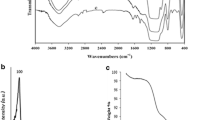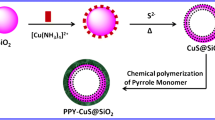Abstract
The paper describes a one-step synthetic method to chemically reduce cupric sulfate by ascorbic acid in the presence of DNA strands to directly produce Cu x O@DNA spheres. The DNA strands act as template to assist the preparation of Cu x O, and also are capable of specifically binding Pb(II) ions. The Cu x O@DNA spheres possess high specific surface area and strong bioaffinity. They can be directly employed as platform for detecting Pb2+ sensitively. Electrochemical impedance spectroscopy data showed that the assay exhibits high sensitivity and a wide linear analytical range that extends from 0.1 to 100 nM, and the detection limit is 6.8 pM at a signal-to-noise ratio of 3. The assay is selective, acceptably reproducible, stable, and well feasible for the detection of Pb2+ in blood serum.

Schematic presentation of the preparation of DNA-templated Cu x O spheres (Cu x O@DNA) for use in electrochemical detection of Pb2+. The assay exhibits detection limit of 6.8 pM, high selectivity, acceptable reproducibility, stability, and good applicability for Pb2+ detection.




Similar content being viewed by others
References
Yeh H, Sharma J, Han JJ, Martinez JS, Werner JH (2010) A DNA−silver nanocluster probe that fluoresces upon hybridization. Nano Lett 10:3106–3110
Richards CI, Choi S, Hsiang J, Antoku Y, Vosch T, Bongiorno A, Tzeng Y, Dickson RM (2008) Oligonucleotide-stabilized ag nanocluster fluorophores. J Am Chem Soc 130:5038–5039
Sha L, Zhang X, Wang G (2016) A label-free and enzyme-free ultra-sensitive transcription factors biosensor using DNA-templated copper nanoparticles as fluorescent indicator and hairpin DNA cascade reaction as signal amplifier. Biosens Bioelectron 82:85–92
Zhang L, Zhao J, Zhang H, Jiang J, Yu R (2013) Double strand DNA-templated copper nanoparticle as a novel fluorescence indicator for label-free detection of polynucleotide kinase activity. Biosens Bioelectron 44:6–9
Zhou Z, Du Y, Dong S (2011) Double-strand DNA-templated formation of copper nanoparticles as fluorescent probe for Label-Free aptamer sensor. Anal Chem 83:5122–5127
Chen J, Ji X, Tinnefeld P, He Z (2016) Multifunctional dumbbell-shaped DNA-templated selective formation of fluorescent silver nanoclusters or copper nanoparticles for sensitive detection of biomolecules. Acs Appl Mater Interfaces 8:1786–1794
Rotaru A, Dutta S, Jentzsch E, Gothelf K, Mokhir A (2010) Selective dsDNA-templated formation of copper nanoparticles in solution. Angew Chem Int Ed 49:5665–5667
Liu M, Liu R, Chen W (2013) Graphene wrapped Cu2O nanocubes: non-enzymatic electrochemical sensors for the detection of glucose and hydrogen peroxide with enhanced stability. Biosens Bioelectron 45:206–212
Hsu Y, Lin H, Chen M, Chen Y, Lin Y (2014) Polarity-dependant performance of p-Cu2O/n-ZnO heterojunction solar cells. Electrochim Acta 144:295–299
Ma C, Zhu L, Chen S, Zhao Y (2013) Simple and rapid preparation of CuO nanowires and their optical properties. Mater Lett 108:114–117
Huang W, Lyu L, Yang Y, Huang MH (2012) Synthesis of Cu2O nanocrystals from cubic to rhombic dodecahedral structures and their comparative photocatalytic activity. J Am Chem Soc 134:1261–1267
Hsu Y, Yu C, Chen Y, Lin Y (2013) Synthesis of novel Cu2O micro/nanostructural photocathode for solar water splitting. Electrochim Acta 105:62–68
Wang L, Wei G, Qi B, Zhou H, Liu Z, Song Y, Yang X, Li Z (2006) Electrostatic assembly of Cu2O nanoparticles on DNA templates. Appl Surf Sci 252:2711–2716
Cai A, Wang Y, Du L, Ma Z (2012) DNA-templated apple-like cuprous oxide. Mater Lett 70:149–151
Reda HASA (2012) Smooth and conductive DNA-templated Cu2O nanowires: growth morphology, spectroscopic and electrical characterization. Nanotechnology 23:75601
Runnells DD, Shepherd TA, Angino EE (1992) Metals in water. determining natural background concentrations in mineralized areas. Environ Sci Technol 26:2316–2323
Jang A, Seo Y, Bishop PL (2005) The removal of heavy metals in urban runoff by sorption on mulch. Environ Pollut 133:117–127
Shams E, Torabi R (2006) Determination of nanomolar concentrations of cadmium by anodic-stripping voltammetry at a carbon paste electrode modified with zirconium phosphated amorphous silica. Sensors Actuators B Chem 117:86–92
Barton J, García MBG, Santos DH, Fanjul-Bolado P, Ribotti A, McCaul M, Diamond D, Magni P (2016) Screen-printed electrodes for environmental monitoring of heavy metal ions: a review. Microchim Acta 183:503–517
Dai X, Qiu F, Zhou X, Long Y, Li W, Tu Y (2014) Amino-functionalized MCM-41 for the simultaneous electrochemical determination of trace lead and cadmium. Electrochim Acta 144:161–167
Chen X, Tian R, Zhang Q, Yao C (2014) Target-induced electronic switch for ultrasensitive detection of Pb2+ based on three dimensionally ordered macroporous Au–Pd bimetallic electrode. Biosens Bioelectron 53:90–98
Lin Z, Chen Y, Li X, Fang W (2011) Pb2+ induced DNA conformational switch from hairpin to G-quadruplex: electrochemical detection of Pb2+. Analyst 136:2367
Zhang Z, Zhang S, Liu S, Wang M, Fu G, He L, Yang Y, Fang S (2015) Electrochemical aptasensor based on one-step synthesis of Cu2O@aptamer nanospheres for sensitive thrombin detection. Sensors Actuators B Chem 220:184–191
Iordanescu CR, Tenciu D, Feraru ID, Kiss A, Bercu M, Savastru D, Notonier R, Grigorescu CEA (2011) Structure and morphology of Cu-oxides films derived from PLD processes. Dig J Nanomater Biostruct 6:863–868
Papadimitropoulos G, Vourdas N, Vamvakas VE, Davazoglou D (2005) Deposition and characterization of copper oxide thin films. J Phys Conf Ser 10:182–185
Wei J, Fang L, Liang X, Su D, Guo X (2015) A sensitive and selective UPLC–MS/MS method for simultaneous determination of 10 alkaloids from Rhizoma Menispermi in rat plasma and its application to a pharmacokinetic study. Talanta 144:662–670
Zhan F, Gao F, Wang X, Xie L, Gao F, Wang Q (2016) Determination of lead(II) by adsorptive stripping voltammetry using a glassy carbon electrode modified with β-cyclodextrin and chemically reduced graphene oxide composite. Microchim Acta 183:1169–1176
Zhou Y, Tang L, Zeng G, Zhang C, Xie X, Liu Y, Wang J, Tang J, Zhang Y, Deng Y (2016) Label free detection of lead using impedimetric sensor based on ordered mesoporous carbon–gold nanoparticles and DNAzyme catalytic beacons. Talanta 146:641–647
Taghdisi SM, Danesh NM, Ramezani M, Alibolandi M, Abnous K (2017) Voltammetric determination of lead(II) by using exonuclease III and gold nanoparticles, and by exploiting the conformational change of the complementary strand of an aptamer. Microchim Acta 184:2783–2790
Zhang B, Lu L, Hu Q, Huang F, Lin Z (2014) ZnO nanoflower-based photoelectrochemical DNAzyme sensor for the detection of Pb2+. Biosens Bioelectron 56:243–249
Cui L, Wu J, Li J, Ju H (2015) Electrochemical sensor for lead cation sensitized with a DNA functionalized porphyrinic metal–organic framework. Anal Chem 87:10635–10641
Wang X, Yang C, Zhu S, Yan M, Ge S, Yu J (2017) 3D origami electrochemical device for sensitive Pb2+ testing based on DNA functionalized iron-porphyrinic metal-organic framework. Biosens Bioelectron 87:108–115
Kanyong P, Rawlinson S, Davis J (2016) Gold nanoparticle modified screen-printed carbon arrays for the simultaneous electrochemical analysis of lead and copper in tap water. Microchim Acta 183:2361–2368
Liu X, Li Z, Ding R, Ren B, Li Y (2016) A nanocarbon paste electrode modified with nitrogen-doped graphene for square wave anodic stripping voltammetric determination of trace lead and cadmium. Microchim Acta 183:709–714
Acknowledgements
This work was supported by Programs for the National Natural Science Foundation of China (NSFC: Account Nos. U1604127 and 21601161), Doctoral research foundation of Zhengzhou University of Light Industry (No. 13501050056), and Innovative Technology Team of Henan Province (CXTD2014042).
Author information
Authors and Affiliations
Corresponding author
Ethics declarations
The author(s) declare that they have no competing interests.
Electronic supplementary material
ESM 1
(DOC 3657 kb)
Rights and permissions
About this article
Cite this article
Song, Y., Guo, C., Ji, H. et al. Cu x O@DNA sphere-based electrochemical bioassay for sensitive detection of Pb2+. Microchim Acta 185, 186 (2018). https://doi.org/10.1007/s00604-018-2729-2
Received:
Accepted:
Published:
DOI: https://doi.org/10.1007/s00604-018-2729-2




